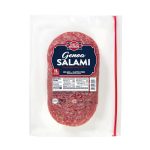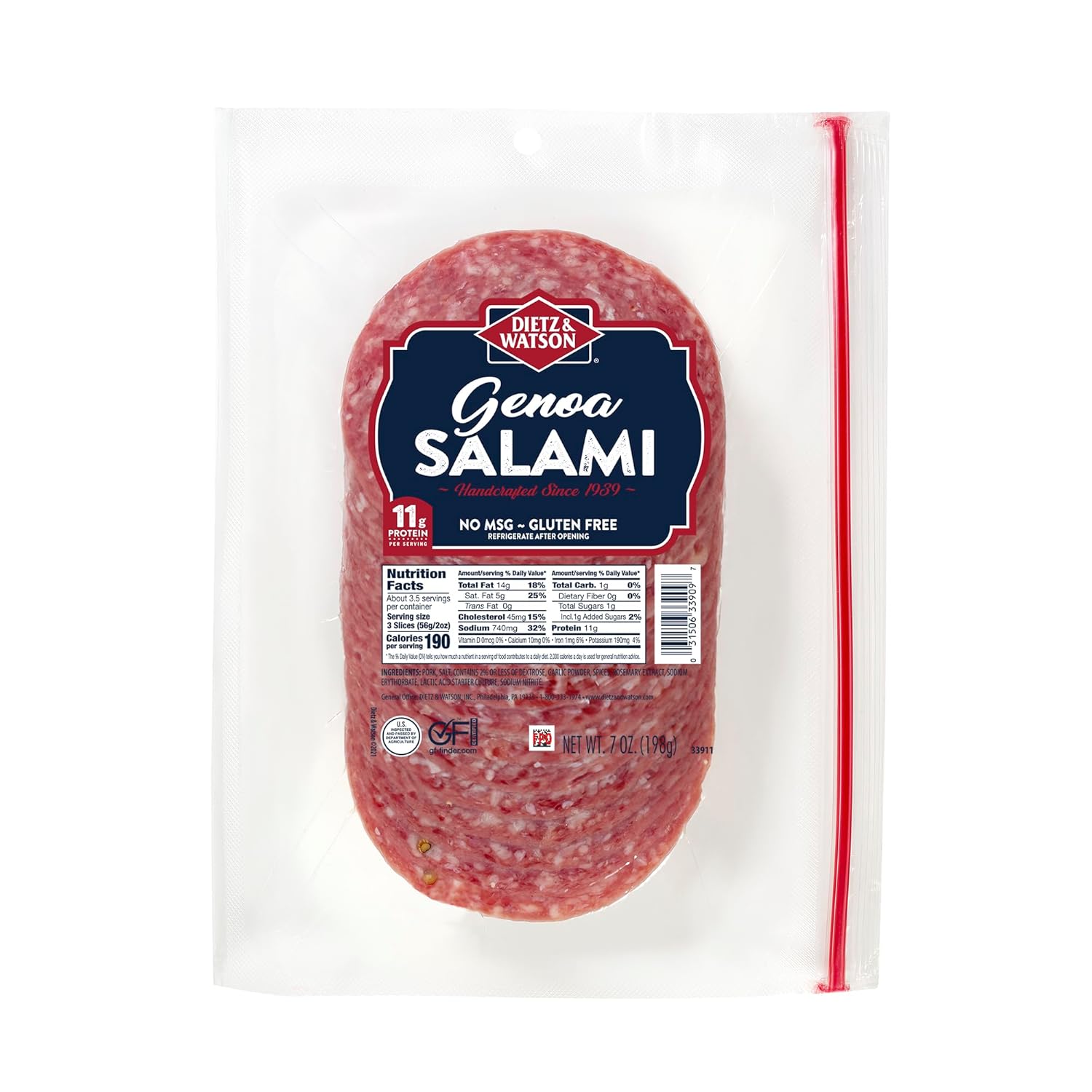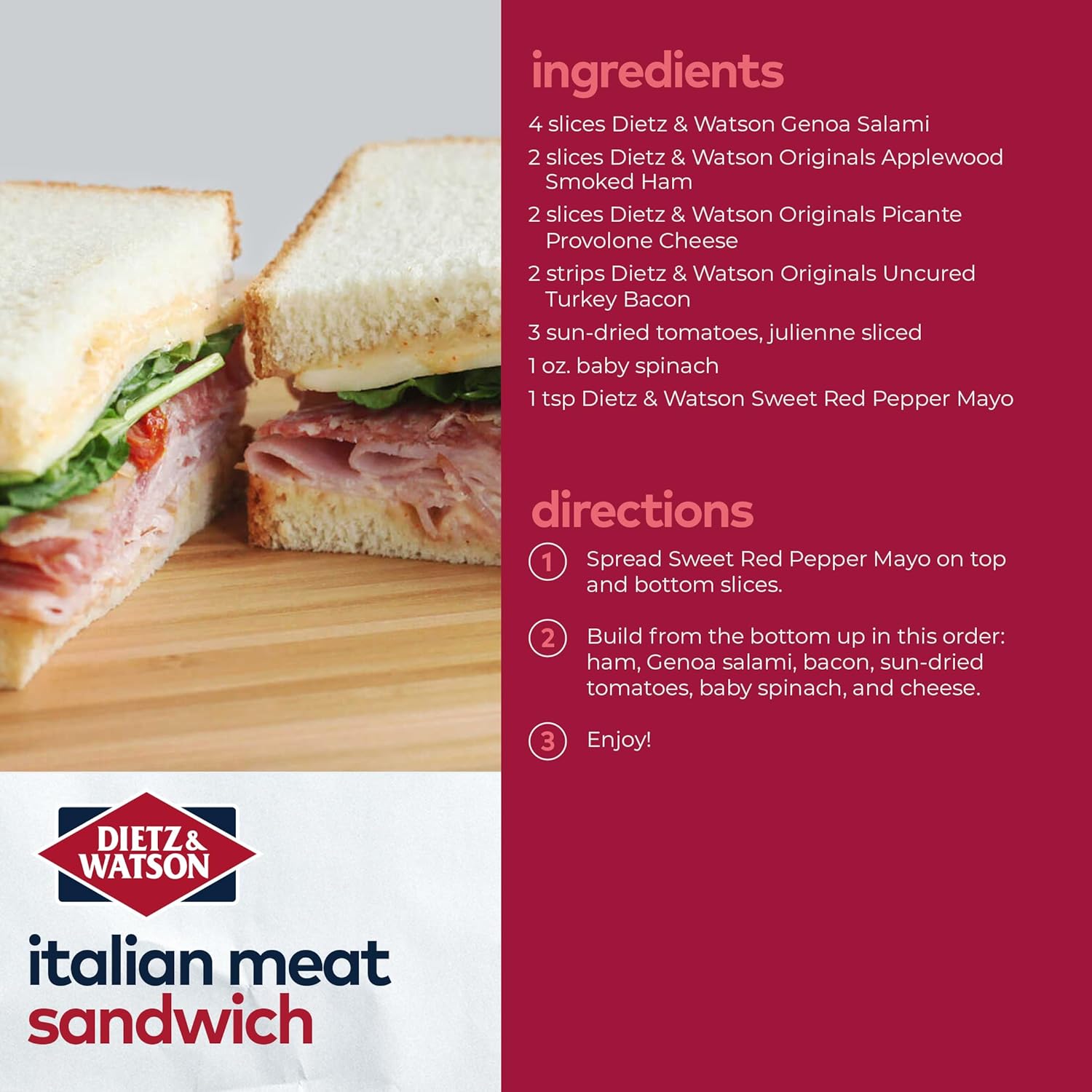
Dietz & Watson Pre-Sliced Genoa Salami, Review salami Buying Guide – Oemiu
Dietz & Watson Pre-Sliced Genoa Salami: A Comprehensive Review and Salami Buying Guide
The world of cured meats is vast and flavorful, and at the heart of many charcuterie boards and sandwiches lies salami. Among the many varieties available, Genoa salami stands out with its distinctive blend of pork and subtle seasonings. This article dives deep into Dietz & Watson’s pre-sliced Genoa salami, offering a thorough review of its taste, texture, ingredients, and overall value. Beyond the review, we’ll explore a comprehensive buying guide to help you navigate the sometimes-overwhelming world of salami, ensuring you make the best choice for your palate and purposes.
Unpacking the Flavor: A Dietz & Watson Genoa Salami Review
Dietz & Watson has built a reputation for quality deli meats, and their Genoa salami is no exception. This pre-sliced offering promises convenience without sacrificing the authentic taste that Genoa salami aficionados crave. But does it live up to the hype? Let’s break down the key aspects of this popular salami.
The first thing you’ll notice upon opening a package of Dietz & Watson Genoa salami is the aroma. It’s a pleasant mix of pork, garlic, and a hint of spice. The slices themselves are typically thin and uniform, making them ideal for sandwiches or layering on a charcuterie board. The color is a rich, reddish-pink, indicative of the curing process. However, color can vary slightly depending on the batch and curing time, a completely normal occurrence with naturally cured meats.
Taste, of course, is paramount. Dietz & Watson’s Genoa salami delivers a balanced flavor profile. The pork is the star, providing a savory foundation, while the garlic and other spices offer a subtle complexity. It’s not overly salty, which is a common complaint with some salami brands. The texture is smooth and slightly chewy, offering a satisfying mouthfeel. While some might prefer a coarser grind, the fine texture of Dietz & Watson’s version allows the flavors to meld together nicely. The slightly tangy flavor is what truly defines this type of salami.
One of the key advantages of pre-sliced salami is convenience. It saves time and effort, especially when preparing meals or assembling snacks. Dietz & Watson’s pre-sliced Genoa salami is packaged in a resealable container, which helps to maintain freshness. However, it’s important to note that even with proper storage, pre-sliced salami will typically have a shorter shelf life than a whole salami log. Furthermore, this particular *salami log* is known for its fresh flavor, so be sure to store it properly.
When considering the overall value, Dietz & Watson Genoa salami falls into a mid-range price point. It’s not the cheapest salami on the market, but it’s also not the most expensive. The quality of the ingredients and the consistent flavor make it a worthwhile investment for those who appreciate good deli meat. Overall, it’s a solid choice for a convenient and flavorful Genoa salami option.
| Feature | Description |
|---|---|
| Flavor Profile | Balanced pork flavor with garlic and subtle spice |
| Texture | Smooth and slightly chewy |
| Packaging | Resealable container for freshness |
| Price Point | Mid-range |
| Convenience | Pre-sliced for easy use |
Ingredient Analysis: What’s in Your Salami?
Understanding the ingredients in your food is crucial, especially when it comes to processed meats like salami. Dietz & Watson lists pork, salt, dextrose, spices, garlic, sodium nitrite, sodium nitrate, and lactic acid starter culture as key components. While these ingredients are fairly standard for Genoa salami, let’s take a closer look.
Pork, of course, is the primary ingredient. The quality of the pork used will significantly impact the final flavor and texture. Salt acts as a preservative and also contributes to the flavor. Dextrose, a type of sugar, is often added to salami to help with the fermentation process and to balance the saltiness. Spices, including garlic, are essential for creating the characteristic Genoa salami flavor profile.
Sodium nitrite and sodium nitrate are curing agents that prevent the growth of harmful bacteria and contribute to the characteristic pink color of cured meats. While these ingredients have been the subject of some debate, they are generally considered safe when used in regulated amounts. Lactic acid starter culture is used to initiate the fermentation process, which helps to develop the unique flavor and texture of salami. The importance of the lactic acid culture to the production of a fine salami cannot be overstated, and the final product’s aroma is improved.
It’s also worth noting what’s *not* in Dietz & Watson’s Genoa salami. The product is gluten-free, which is good news for those with gluten sensitivities. The company also emphasizes that their products are free from artificial colors and flavors. However, it’s always a good idea to carefully read the ingredient list to ensure that the product meets your specific dietary needs and preferences.
The Art of Salami Selection: A Comprehensive Buying Guide
Choosing the right salami can be a daunting task, given the sheer variety available. From *sopressata salami* to *cacciatore salami*, each type offers a unique flavor profile and texture. This buying guide will equip you with the knowledge you need to navigate the world of salami with confidence.
First, consider the type of salami you’re looking for. Genoa salami, as we’ve discussed, is a classic choice with a balanced flavor. Other popular options include:
* **Sopressata:** Typically made with coarser ground pork and flavored with black peppercorns and other spices. It often has a more robust and peppery flavor than Genoa salami.
* **Cacciatore:** A small, dry-cured salami often seasoned with garlic and paprika. It’s a great option for snacking.
* **Pepperoni:** A spicy salami made with paprika and chili pepper. It’s a staple on pizzas and sandwiches.
* **Felino:** A soft, sweet salami originating from Italy, often paired with parmesan cheese.
* **Hard Salami:** Characterized by its high degree of dryness, hard salami has a long shelf life and intense flavor.
Once you’ve decided on the type of salami, consider the ingredients. Look for salami made with high-quality pork and natural spices. Avoid salami with excessive amounts of artificial ingredients, fillers, or preservatives. The ingredient list should be relatively short and easy to understand. Furthermore, the texture of salami is important. Do you like it rough or well ground? Also, where did the animal that became the salami originate from? This will affect the flavor too.
The appearance of the salami can also be an indicator of quality. Look for salami with a rich, even color. Avoid salami that looks pale, dry, or discolored. The casing should be intact and free from cracks or tears. If you’re buying pre-sliced salami, make sure the slices are uniform in thickness and free from any signs of spoilage.
Another important factor to consider is the price. Salami prices can vary widely depending on the type, quality, and brand. While it’s tempting to opt for the cheapest option, remember that you often get what you pay for. Investing in a slightly more expensive salami can result in a significantly better flavor and overall experience. Look into imported salami if you’re feeling fancy. Also, consider the value that the salami is bringing to your family’s meals: How many meals will the salami provide? This is particularly important to families that are on a tight budget.
Navigating the Labyrinth: Deciphering Salami Labels
Reading salami labels can feel like deciphering a foreign language. Understanding the common terms and certifications can help you make informed choices and select the best salami for your needs.
Look for terms like “naturally cured” or “uncured,” which indicate that the salami was cured using natural ingredients like celery powder rather than synthetic nitrates or nitrites. However, it’s important to note that even “uncured” salami still undergoes a curing process and contains nitrates or nitrites from natural sources. These nitrates are converted to nitrites by the bacterial starter cultures.
Certifications such as “USDA Organic” or “Certified Humane” can provide assurance about the farming practices used to raise the pork. These certifications indicate that the animals were raised in accordance with specific standards for animal welfare and environmental sustainability. For example, look for “American Humane Certified.”
Pay attention to the “use by” or “best by” date on the package. This date indicates how long the salami is expected to maintain its optimal quality. While salami is a cured meat and generally has a longer shelf life than fresh meat, it’s still important to consume it within a reasonable timeframe. Once opened, pre-sliced salami should be consumed within a few days to prevent spoilage.
Finally, consider any allergens or dietary restrictions you may have. Many salami varieties contain common allergens like milk, soy, or nuts. Always read the ingredient list carefully to ensure that the salami is safe for you to consume. Some salami is also made with pork that is harvested in specific ways that may clash with religious beliefs. Be sure to check and verify if this is important to you.
Serving Suggestions and Culinary Pairings: Elevating Your Salami Experience
Salami is a versatile ingredient that can be enjoyed in countless ways. From simple snacks to elegant appetizers, salami can add a touch of flavor and sophistication to any meal. Knowing how to serve and pair salami properly can elevate your culinary experience.
For a simple snack, try pairing salami with crackers, cheese, and olives. A classic combination is Genoa salami with provolone cheese and crusty bread. For a more elaborate charcuterie board, include a variety of salami, cheeses, fruits, nuts, and spreads. Experiment with different textures and flavors to create a visually appealing and palate-pleasing display. Another, sweeter salami is *finocchiona salami*, known for its distinct fennel flavor.
Salami is also a great addition to sandwiches. Use it as a layer in Italian subs, or add it to grilled cheese sandwiches for a boost of flavor. Salami can also be used in salads, pizzas, and pasta dishes. Try adding diced salami to a frittata or omelet for a savory breakfast option. It can also be grilled and added to a salad.
When it comes to pairing salami with wine, consider the flavor profile of the salami. Genoa salami, with its balanced flavor, pairs well with a variety of wines, including Chianti, Pinot Noir, and Sauvignon Blanc. Sopressata, with its bolder flavor, can stand up to richer wines like Cabernet Sauvignon or Syrah. Cacciatore, with its spicy kick, pairs well with lighter wines like Beaujolais or Riesling.
Beyond wine, salami also pairs well with beer. A crisp pilsner or a hoppy IPA can complement the savory flavor of salami. Experiment with different beer styles to find your favorite pairing. Non-alcoholic beverages like sparkling water, iced tea, or lemonade can also be refreshing accompaniments to salami. Ultimately, the best pairing is the one that you enjoy the most. Consider *dry-cured salami* with an ice-cold beverage during hot summer months.
Frequently Asked Questions (FAQ)
What is the difference between Genoa salami and other types of salami?
Genoa salami is a type of dry-cured pork salami that originated in Italy. It’s typically made with pork, salt, spices (including garlic), and a lactic acid starter culture. The main difference lies in the spice blend and the curing process. Genoa salami has a milder, more balanced flavor compared to spicier or more intensely flavored salami like pepperoni or soppressata. Genoa salami is also cured for a shorter period than some other types, resulting in a slightly softer texture. Different salami types may also use different cuts of pork, affecting the texture and fat content. Overall, Genoa salami is a versatile and widely appealing option due to its approachable flavor profile. Consider *Italian dry salami* if you’re looking for something classic.
How should I store pre-sliced salami to maintain freshness?
Pre-sliced salami, like Dietz & Watson’s, is best stored in the refrigerator in its original, resealable packaging. If the original packaging is no longer available, transfer the salami to an airtight container or wrap it tightly in plastic wrap or aluminum foil. Properly stored pre-sliced salami can typically last for about 3-5 days in the refrigerator. Look for signs of spoilage, such as a slimy texture, sour odor, or discoloration, before consuming. To maximize freshness, avoid exposing the salami to air and moisture, as this can accelerate spoilage. Consider placing a paper towel in the container to absorb excess moisture. Also, avoid cross-contamination from other foods. Pre-sliced salami will typically not last as long as a whole salami log because it has more surface area exposed to the air.
Is salami healthy? What are the nutritional considerations?
Salami, like other processed meats, should be consumed in moderation as part of a balanced diet. It’s a good source of protein and certain vitamins and minerals, but it’s also high in sodium and saturated fat. Sodium is used as a preservative, and saturated fat is naturally found in pork. The exact nutritional content varies depending on the type of salami and the specific ingredients used. Pay attention to serving sizes and consider limiting your intake of salami if you have concerns about sodium, saturated fat, or cholesterol. Look for lower-sodium options or leaner salami varieties if you’re watching your intake. It’s important to balance your salami consumption with plenty of fruits, vegetables, and whole grains.
Can I freeze salami?
Yes, you can freeze salami, but the texture may change slightly after thawing. Whole salami logs generally freeze better than pre-sliced salami because they have less surface area exposed to the air. To freeze salami, wrap it tightly in plastic wrap and then in aluminum foil or place it in a freezer-safe bag. Frozen salami can last for up to 2-3 months in the freezer. When you’re ready to use it, thaw it in the refrigerator overnight. Be aware that the texture of the thawed salami may be slightly softer or more watery than fresh salami. Pre-sliced salami may become more difficult to separate after freezing and thawing. It’s best to use frozen salami in cooked dishes where the texture is less critical.
What are some creative ways to use salami in cooking?
Salami is incredibly versatile and can be incorporated into a wide range of dishes. Beyond the traditional sandwiches and charcuterie boards, try adding diced salami to omelets, frittatas, or quiches for a savory breakfast option. It can also be used as a topping for homemade pizzas or stirred into pasta sauces for added flavor. Consider adding salami to salads for a protein boost, or use it as a filling for stuffed peppers or zucchini. For a simple appetizer, wrap salami around melon or cheese cubes. Experiment with different flavor combinations to create your own signature salami dishes. Consider grilling salami for a charred flavor before adding it to a salad. A *dry cured sausage* like salami would make a fine ingredient for stuffing ravioli, too.
How can I tell if salami has gone bad?
Several signs indicate that salami has gone bad. The most obvious is a change in smell. Fresh salami has a pleasant, slightly tangy aroma, while spoiled salami will have a sour, ammonia-like, or otherwise unpleasant odor. The texture can also be an indicator. Sliminess or excessive moisture on the surface of the salami suggests bacterial growth and spoilage. Discoloration, such as a greenish or grayish tint, is another warning sign. If you see mold growing on the salami, it’s best to discard it. While some molds are harmless on certain types of aged cheese, it’s not worth the risk with salami. When in doubt, it’s always better to err on the side of caution and throw it away. It’s also important to check the “use by” or “best by” date on the packaging.
What are some good cheese pairings with Genoa salami?
Genoa salami, with its mild and balanced flavor, pairs well with a variety of cheeses. Provolone is a classic pairing, as its mild, slightly tangy flavor complements the savory pork and garlic notes of the salami. Another great option is mozzarella, especially fresh mozzarella, which provides a creamy and slightly sweet contrast to the salami’s saltiness. For a bolder pairing, try sharp cheddar or Parmesan cheese. The robust flavors of these cheeses can stand up to the salami’s richness. Other good choices include Swiss, Gouda, and Gruyere. Ultimately, the best cheese pairing depends on your personal preferences. Experiment with different combinations to find your favorite. Some people like goat cheese, which provides a sour note to balance the saltiness of the salami.










